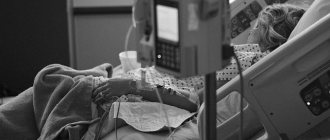What is neurasthenia and how does it develop?
Neurosis develops as a consequence of a disorder of the brain, namely the part that is responsible for human adaptation. The consequences of neuralgia can affect not only the mental and emotional state of the patient, but also negatively affect the functioning of various body systems and internal organs, since everything in the human body is interconnected.
Anxiety causes a strong release of adrenaline, which increases the secretion of pituitary hormones and insulin, which regulate the functioning of the thyroid gland. Such hormones increase the likelihood of panic attacks.
How to distinguish neurasthenia from other disorders?
People suffering from emotional distress experience various feelings more emotionally than others. Anger, anxiety, despair, aggression, envy - these are just some of the manifestations of neurosis in humans. During such conditions, the patient experiences an increased level of stress, so negative situations are perceived more acutely and seriously than they actually are.
Neurosis is based on traumatic circumstances, psychological trauma, stress or prolonged emotional and intellectual overstrain. Neurasthenia is often encountered by people who have recently experienced a serious emotional shock or the loss of loved ones.
People suffering from neurosis often deny their feelings, emotions, and try to distance themselves from their own reality. They find it difficult to control and manage their emotions. The disorder distorts the patient's rational thinking and does not allow him to function normally in the family, social and work spheres of life.
From man to monkey
— How does linguistic consciousness manifest itself and what does its loss lead to?
— The word contains a certain concept. We have a world of material objects and we have words for them. In order for us to comprehend the connections between objects, we do not need them ourselves, we use words.
The word has all the characteristics of an object. We know that a hammer is needed for hammering nails, but it is absolutely not suitable for petting a cat. And we don't need to do the cat-smoothing experiment. This is what abstract thinking is all about.
A child under one year old performs only manipulative actions. That is, he tries the properties of objects as material objects: how they sound, knock, whether they can be crushed, torn, stretched, whether they fit in his mouth.
And only later does he discover objects for himself from the point of view of their functional, cultural meaning. It’s more convenient to eat with your hands, but my mother gives me a spoon. And the point is not that motor skills need to be rebuilt, the psyche is also rebuilt. The child comprehends the objective meaning of a spoon as a tool. In the future, he can feed the doll with a stick, but put the concept of a spoon into it. Only a person can comprehend and make such a substitution.
Baby.
CC0.
Therefore, it is important to surround the child with toys that are similar to the objective world of adults. The more words and their connections with objects, the more abstract and complex thinking becomes.
Imagine that you are a discoverer of a planet and see an unfamiliar object. It doesn't mean anything. You can take it in your hand, squeeze it, knock it. Like a baby. Its cultural significance will remain incomprehensible.
The catastrophe is that language loses its complexity, concepts are reduced and “flattened” in it. Accordingly, thinking ceases to be abstract and becomes more and more concrete and visual.
There is, for example, a painting as a thing, as an object of art. But in order to comprehend the meaning embedded in it, you need to learn it, just like wielding a spoon. And, unfortunately, we are losing this opportunity.
In the end, if the process develops linearly like this, it will turn out that a person will walk among the cultural objects of the world, not recognizing their meaning, seeing in them only a material function. First, past museums and theaters, and then, apparently, past that very spoon. That is, turn back into a monkey.
An exhibition of Soviet art opened at the Art Museum.
Anna Zaikova
We, of course, will not trip over the statue of David, for example, but we will perceive it simply as a piece of stone.
The psyche develops according to certain laws that cannot be bypassed or circumvented. And even more so, you cannot deceive them and try to stimulate development.
We have already said that more and more individuals with an undeveloped and malformed nervous system are appearing in the human population. This is a property of the brain tissue itself. And the worst thing is that, roughly speaking, these weak brains are inherited.
And again they find themselves in the same conditions that are not conducive to development. This is a software error, it accumulates in the population and leads to degradation.
Symptoms of neurosis
Pathology manifests itself both at the physical and psycho-emotional levels. Physical symptoms include increased sweating, rapid heartbeat, chest pain and dry mouth, headaches, blurred vision, tremors of the limbs, skin rashes, and menstrual irregularities in women.
Psychological symptoms: a feeling of loss of control, a feeling that the person is “going crazy”, fear of sudden death, excessive worry, high sensitivity and vulnerability.
- Irritability;
- Constant feeling of fatigue and apathy;
- Increased sensitivity;
- Social isolation;
- Frequent and unexpected mood swings;
- Disturbances in sleep and wakefulness;
- Loss of interest in life or certain areas of it.
It is the constant feeling of anxiety for one’s life or the lives of loved ones that causes insomnia in a person. Problems with sleep do not allow the body and nervous system of those suffering from neurasthenia to fully rest. This, in turn, further intensifies all the symptoms listed above.
Therefore, for insomnia, experts recommend several simple and effective rules:
- Follow a daily routine, that is, try to fall asleep and wake up at the same time;
- Play sports, giving the body a light load;
- Be in the fresh air more often;
- Reduce the number of drinks containing caffeine;
- Eat light foods to avoid stomach discomfort.
For what reasons does neurosis develop?
- Strong mental activity;
- Prolonged psychological distress and anxiety;
- Psychological pressure due to the inability to solve life problems;
- Long-term loneliness and problems in the personal sphere of life;
- Traumatic event in life: loss of a loved one, difficult divorce, difficult financial situation, if the person has been subjected to emotional and physical abuse, etc.;
- High expectations. In this case, the person cannot achieve the desired goal and experiences a feeling of an impossible plan;
- Psychological trauma received in childhood: humiliation or beating from peers and parents, example of a bad lifestyle from adults, harsh upbringing;
- Failure to comply with work and rest schedules.
The shortcut is in the way
— Modern children are increasingly born not very healthy. Nobody denies this fact anymore. Why, in addition to physical problems, do they also get mental ones?
— There are many stories when at different stages of pregnancy there is a threat of miscarriage, that is, nature itself makes a not very favorable prognosis for this fetus and tries to get rid of it.
But modern medicine has learned to nurse such “fruits”. Many children are born by caesarean section, that is, they do not pass through the birth canal and, accordingly, do not physically receive enough stimulation to trigger certain processes of the nervous system. With an unsuccessful pregnancy and the same birth, we have problems from the very beginning.
- What will happen to such a child next?
— An initially weak nervous system cannot withstand the stress that a normal one would endure. Most of these children have one or another neurological symptoms - delays in motor or speech development. For example, now many babies do not crawl, they simply skip this period. Or they have trouble using both hands at the same time.
Also, children may be overly sensitive to any stimulation: noise, loud sounds, stuffiness become a big challenge for them, they cannot even stand the touch of a label on clothing.
This is manifested in behavior by the fact that the child is distracted and capricious. But he does this not because he wants to annoy his parents, but because his nervous system cannot cope with the sensory load, he feels bad. Imagine that you have itching all over your body. Will it be easy for you to remain calm and at the same time solve intellectual problems?
Larisa Golovina, neuropsychologist.
Anna Zaikova.
Features of the course of neurosis in women
Neurosis is diagnosed in a third of the world's urban population. Neurology is one of the most common ailments of the nervous system—the disease occurs in every fourth person with mental illness. A study of the incidence of neurosis has shown that neurotic disorders are common in men and women over 30 years of age. However, neurotic disorders in women usually occur in a more severe form than in men.
The reason for such conclusions is the emotionality of women. Doctors note that neurosis most often appears in expressive and emotional people. According to statistics, women are more sensitive than men.
Experts also say that, unlike men, women suffer from neurosis almost twice as much. Menopause is considered one of the causes of neurosis in women. Any hormonal changes affect our nervous system and can bring unpleasant consequences.
Perhaps, in this case, a social factor also plays a role - men are less likely to go to doctors, especially to a psychotherapist. However, today experts say that the flow of men to psychotherapists has increased, but women are still more willing to go to a doctor for help.
Also, by the will of fate and centuries-old traditions, not only a career and daily work falls on a woman’s shoulders, but also cleaning the house and raising children. The modern woman has more tasks, the principle “you need to be strong and hold on” is firmly stuck in your head. However, this unknown force will not protect you from overload and fatigue. Then for help you need to contact a psychotherapist who will prescribe treatment. Psychotherapy sessions help to influence the cause of neurosis, change the attitude towards a traumatic situation and facilitate the release of emotions, accelerating recovery.
Symptoms of neurosis in women
The signs of neurosis in women differ from the opposite sex due to our physiological characteristics of the body. For example, among women the list of symptoms of neurosis includes insomnia, frequent nightmares and sleep paralysis, but this is not observed in men. Also, in women with neurosis, there is a deviation in the menstrual cycle.
Doctors identify the following most common symptoms of neurosis in women:
- anxiety;
- irritability;
- expressiveness of behavior;
- refusal to eat;
- impairment of physical qualities: loss of strength, feeling tired, loss of endurance;
- heart and headaches;
- vestibular disorders, balance disorders
- excessive tearfulness;
- sudden mood swings.
There are several types of neurosis, one of them is hysterical, most often called hysteria. According to doctors, signs of this type of disease are most often observed in women. Experts interpret hysterical disorder as an ardent desire to attract attention to the sick person. The disease is characterized by demonstrative behavior. A person suffering from such a disease often screams loudly, makes scandals, and sobs bitterly.
Medical psychotherapists have extensive experience and all the necessary resources for the successful treatment of neuroses.
Features of the course of neurosis in children
Neurasthenia is also common in children of primary and preschool age. Symptoms of the disorder are similar to those in adults. The difficulty in determining pathology lies only in the fact that young children often cannot explain what is happening to them and how they feel.
The child's appetite decreases, sleep problems appear, and nightmares often occur, as a result of which the baby may even cry out in his sleep and wake up without understanding what is happening. Increased sweating occurs and the temperature of the extremities decreases.
In addition to all the above signs of pathology, the child may have a headache, he is sensitive to bright light and loud sounds. There is also often a sharp change from positive emotions to negative ones: crying, aggression and depression.
Experts recommend immediately seeking help from a doctor, since neurosis in childhood is much more difficult to treat than in adults.
What types of neurosis exist and how do they differ?
- Depressive.
This type of neurosis is characterized by such symptoms in a person as tearfulness, sudden changes in mood, feelings of despair and helplessness. The person suffering from the disorder loses interest in life and becomes melancholy. During depressive neurosis, a person experiences low self-esteem, guilt, and frustration. - Anxious.
Often has manifestations at the physical level: dry mouth, increased sweating, rapid heartbeat. Anxiety neurosis can result in panic attacks and phobias. A person constantly experiences a feeling of fear. - Hysterical (“conversion disorder”)
- most often manifests itself if a person has experienced a strong emotional shock or a traumatic event. There is a change or loss of motor/sensory function indicating a physical disorder that is not detected. For example, after an accident, a person may experience loss of speech, although there is no physical reason for this. - Obsessive-compulsive.
Intrusive thoughts and images appear. Often such thoughts have no rational grain and are catastrophic in nature. To counter the overwhelming anxiety, a person performs compulsive, repetitive actions. - Rehearsal.
It manifests itself as attempts to resolve an issue that in the past remained unfinished. A person suffering from rehearsal neurosis transfers conflicting relationships from the past to the present and believes that this reality still exists today. - Hypochondriacal.
The patient becomes too suspicious and overly concerned about his health; he finds symptoms of various diseases where they actually do not exist. A person invents a terrible disease, torments himself, and stress or anxiety appears. Despite negative tests and consultations with doctors, the patient remains convinced of this. - Depersonalization.
Fear, panic and anxiety appear. It’s as if a person lives in a dream, “disconnecting” from his own body and thoughts. - Military or post-traumatic stress disorder.
It manifests itself under very shocking circumstances, when a person saw death or was captured or suffered serious injuries (physical and psychological). This type of neurasthenia is manifested by very strong stress, panic attacks, and an aggressive state. Such stress is dangerous because it can lead to disability, including functional disability that negatively affects daily life.
For example, a person believes that everyone treats him badly or no one likes him. As a result, he begins to behave in accordance with his ideas about others.
Neurosis and memory problems
Excessive anxiety leads to decreased concentration, which means that the patient often has problems with memory and attention. In order to influence the problem, you can take vitamin complexes of natural origin, as well as conduct useful memory training.
Experts recommend engaging in light physical activity and daily exercise to relieve anxiety and excessive worry.
Try not to multitask, this will only make the problem worse. It is better to remove all distractions while working or doing what you love. Such distractions include a mobile phone or any other mobile device. Turn them off when doing important things.
To reduce the strain on your eyes and brain, take breaks from work and study. Don't overwork yourself. You can take a walk in the fresh air or do some exercise.
Neurosis and psychosis: what is the difference?
Often these concepts are confused or interchanged. But diseases are different in their manifestations and the internal feeling of a person. For example, during the development of obsessive-compulsive neurosis, a person maintains a sense of reality and looks for new ways to adapt to it. He recognizes that he is suffering from a disorder and that this suffering is a product of mental instability.
During psychosis, a person perceives the world around him differently. He adapts reality according to his personal perception (often delusional), experiences hallucinations and delusions. And the main thing is how psychosis differs from neurosis: the patient is not aware of his problem.
Neurosis and vegetative-vascular dystonia
As we mentioned above, during neurosis signs appear on the physical level, such as rapid heartbeat, fluctuations in blood pressure, chest pain, difficulty breathing, etc. All these symptoms are similar to the signs of a disease such as vegetative-vascular dystonia.
VSD is a complex of symptoms of different localization that occur when there is a malfunction in the autonomic nervous system. And neurosis is a disorder of the central nervous system caused by the psyche (stress, depression, etc.). Since the nervous system is connected, disturbances in one department provoke disruptions in the functioning of another.
How is neurasthenia diagnosed?
To diagnose and identify the disease, you need to consult a neurologist, and sometimes a psychologist and psychiatrist. At the city clinic, you can contact your primary care physician, who will write a referral to a neurologist. However, this takes time. You often have to wait 2 weeks for an appointment with a doctor. In some cases, this is simply impossible, since it is necessary to quickly conduct an examination and prescribe treatment before the situation becomes critical.
Therefore, we recommend contacting the Medunion medical clinic. We employ practicing neurologists, and you don’t have to wait several weeks for appointments. Sign up today for a time convenient for you, not for the remaining time, and get tested tomorrow.
Patients choose us because we provide the service of a specialist coming to your home if you cannot come to the clinic on your own. You can also take samples directly at home.
Diagnosis includes interviewing the patient or his immediate family (guardians), collecting anamnesis and studying the medical history. To make a diagnosis, the doctor needs to know the symptoms that bother the patient.
To exclude other pathologies, the neurologist prescribes laboratory tests:
- Blood analysis;
- Analysis of urine;
- Ultrasonography;
- CT scan;
- Magnetic resonance imaging.
The specialist will also conduct psychological tests. For example, color technique. It consists in the fact that the patient is offered a palette of colors from which he must choose the color he likes. Colors such as purple, gray, red, brown, black indicate a high probability of developing neurosis.
Communicative response
— It is clear that the capabilities of children with weakened psyches are initially limited. But how not to make more or less healthy children nervously disabled? What advice can you give to parents?
Ooty little things
“We must definitely get an emotional response from the baby.” This “Oooh, my dear, who is this beautiful one lying here” is a must. An important indicator is the so-called revival complex, when a child reacts to an adult with attempts to smile and agitated jerking of the whole body.
This is a kind of certificate of maturity - a child moves from the newborn stage to the infant stage. If this does not happen within 2.5 months, there is serious cause for concern.
If the nervous system is weak, then this process is delayed, and young mothers, as a rule, give up trying to “revive” the child. But in fact, he needs even more stimulation. It is important to achieve at least some kind of communicative response.
Where is the bear?
— You need to talk a lot with children. And in a certain way. There is an idea that even with kids you need to speak like adults, in long, complex phrases. In no case. Mothers intuitively know how to build a conversation - repeat the same thing slowly and many times: “Mi-i-ishka.” Here he is, mi-i-ishka. Where is mi-i-ishka?”, correlate the word and the object itself, achieve recognition.
Imagine being in China without knowing the language. Until they tell and show you several times that this is tea, you will not understand. In Russian speech, we can understand words and isolate them from the speech stream because we know their meaning. Foreign speech is just a collection of sounds. For a child, adult speech seems exactly like this. He needs to learn to isolate individual words from the entire stream.
Larisa Golovina, neuropsychologist.
instagram.com/neuropsiholog_barnaul.
Letters and numbers
— Let your child play enough at two years old and don’t sit him down with an ABC book. A letter is a symbol; we agreed that it corresponds to some sound. It doesn’t resemble this sound in any way, it’s just a convention.
In a child at this age, those parts of the brain that are responsible for perceiving a symbol as a carrier of some meaning are sleeping sweetly and are not going to work.
For example, you are building a house and spend a certain amount on building materials in each period. And now you are laying the foundation, and here is a beautiful tile on sale. Of course, you buy, but you no longer have the money to waterproof the foundation. You build a house, finish the bath with tiles, but the problem of the foundation remains, there is no way to fix it. What's the gain?
The brain also has a resource allocated to current tasks at each period of time. The brain seems to say: “Okay, let’s process letters and numbers, if you want, then I’ll wake up this area. True, at this time a block is formed that is responsible for the immune system and emotional stability, but it doesn’t matter, it will do, the letters are more important.”
Then we have a person prone to nervous breakdowns and vegetative crises, with a bunch of chronic diseases. But he learned letters at two years old.
Kindergarten, dining room.
pixabay.com
Why gadgets are useless
— All “educational” games for kids on tablets and phones are absolutely useless. The child develops only interaction with the object itself, the real one, and not with a jumping picture on the screen. Until the age of five, no educational games will definitely develop anything, because this is contrary to the laws of the psyche.
Will explain. A picture is the same symbol as a letter; a child recognizes it, but can only “load” it with some meaning only by having experience interacting with such an object in reality.
The psychological basis of speech is also laid only through interaction with the objective world. Early replacement of real objects in the world with symbols leads to disturbances in speech behavior—the basis is flimsy and insufficient for speech development.
This is another global problem that arises from the improper formation of the nervous system - the loss of linguistic consciousness.
Children with phones.
CC0
Methods for treating neurosis
Experts suggest fighting the disease using an integrated approach. This includes drug therapy, physical activity and proper nutrition, sleep and wakefulness, and moderate mental stress.
Drug therapy
Medicines, first of all, are antidepressants that are involved in the uptake of serotonin, dopamine, and norepinephrine. In addition, such drugs help block the enzyme that destroys these hormones. This allows you to increase their volume in the general bloodstream and thereby improve your mood.
These medications do not affect a person’s condition while driving a vehicle and are not addictive, but their effect occurs only a few weeks after the start of use. The duration of the course of therapy can reach 2-3 months.
There are also newer generation antidepressants that are considered safer and have fewer side effects. The duration of therapy and daily dose are determined only by the attending physician. Taking medications on your own without consulting a neurologist is highly undesirable.
Another effective remedy is drugs from the group of tranquilizers, which affect the transmission of nerve impulses in the brain, which makes it possible to slow down the activity of the nervous system and reduce a person’s reaction to a specific stimulus. The drugs have a sedative and anti-anxiety effect on the body.
Psychotherapeutic treatment
Personal psychotherapy allows a person suffering from a nervous disorder to build a picture of his personality and establish the cause that led to neurosis. A doctor helps change a person’s view of the world around him. Recovery occurs if the patient, with the help of a specialist, understands the cause of his fears and worries.
Meditation is also often used. With the help of psychoanalysis you can understand your inner world. Meditation can reduce anxiety and create new beliefs about specific situations.
Diet therapy
A proper diet during neurosis can reduce the load on the body. It is worth eating small portions 4-5 times a day, adding vegetables and fruits to your diet. They contain a high concentration of vitamins and fiber, which is a building material for all body systems.
It is also best to exclude sweets, flour, fried, and highly salty foods. Avoid strong and carbonated drinks. And also do not forget about the drinking regime, at least 1.5 liters of clean water per day.
Breathing exercises and massage
Physical exercise helps normalize the activity of parts of the brain such as the cortex and subcortex, as well as stimulate and calm the nervous system.
At the initial stage of gymnastics, simple exercises are performed that do not involve impact on the muscles and do not require concentration. Over time, the load must be increased. And breathing exercises improve blood circulation in the internal organs and in the brain, which allows you to get rid of pain.
Prevention of the development of neurosis
To prevent the development of neurosis, you need to exclude stressful situations and emotional overloads. Take breaks from work when you are doing heavy mental work.
Do things that are enjoyable and relaxing or soothing. Also suitable for prevention are meditations, which completely relax the body and mind and lift your spirits.
And don’t forget, if you feel constant panic attacks, a decline in emotional state, or other alarming symptoms of neurosis, consult a specialist.
Bad habits
You can restore your nerves and get a positive result only by giving up alcohol, cigarettes or psychoactive substances. The absence of bad habits in a person is the main condition for the health of the body.
For example, many people believe that alcohol is practically harmless. However, even with rare consumption of small quantities of alcoholic beverages, increased stimulation of the nervous system and disruptions in its functioning occur. Regular drinking leads to the development of various diseases. These ailments also negatively affect the nervous system.
As for smoking, it reduces a person’s attentiveness, memory and even level of intelligence. This effect occurs due to the constriction of blood vessels in the brain, which provokes oxygen starvation, as well as due to the ingestion of toxic substances that are present in cigarettes.
Even a cup of coffee has a negative effect on the nervous system. Initially, it increases the activity of the NS, and then sharply reduces it. Gradually the nervous system becomes exhausted. A similar thing happens when drinking energy drinks.









